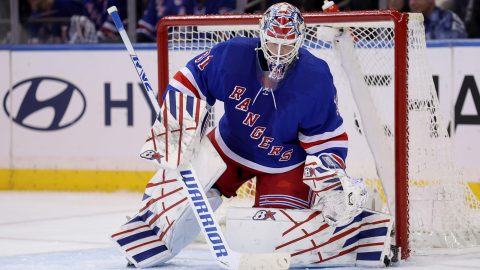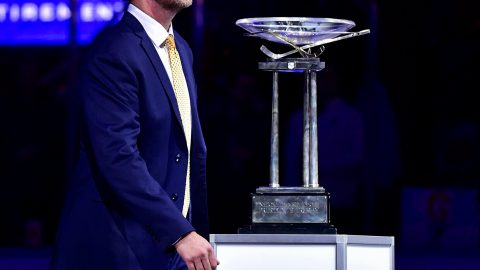Let's see how defensive efficiency (defined as turning balls in play into outs) can impact pitching stats that matter in fantasy baseball.
In the American League, the average team allows hits on 30.7 percent of balls in play, which translates to a .307 average. Note that balls in play do not include homers, which are, by definition, out of play.
In the National League, the rate is about the same (as it always is), at 30.5 percent or .305 average allowed.
Which teams are the major defensive outliers on the plus side (fielding a significantly higher percentage of balls in play)?
In the AL, the leaders are the Mariners (.285 average allowed on BIP) and the Rangers (.295). The only other teams under .300 are the Rays (.297) and Yankees (.299).
The trailers are the Red Sox (.318), Orioles (.315) and A's (.314). Oakland has traditionally been among the leaders as its park has mysteriously reduced batting average in balls in play even after discounting for a normal distribution of pop foul outs given the expansive foul territory.
The NL leaders? The Dodgers (.282), Cubs (.294) and Reds (.296). The trailers? The Astros (.318), Nationals (.315) and Braves (.313).
Given full season stats in a normal year, this kind of difference translates into preventing about 76 hits. Assuming a normal starter's workload (200 innings), the expected share is 13 hits prevented. Figure 2/3 of them are singles. The rest are doubles. That's about 18 total bases, which typically results in four or five runs.
The difference between the leaders and trailers is more dramatic: 114 hits, 20 hits, about 27 total bases and approximately seven runs. Assuming they're all earned, this lowers a 4.00 ERA for a typical starter to 3.69.
Of course, these things are never evenly distributed.
Consider defensive efficiency leaders, the Dodgers and Mariners. For L.A., Jeff Weaver's rate was .306 versus .257 for Randy Wolf. The Mariners range from .226 for Sean White to .321 for Brandon Morrow. Felix Hernandez (.293) wasn't helped nearly as much as Jarrod Washburn (.242), despite far superior stuff.
Same thing for the trailers. Boston's Josh Beckett is .277, versus Jon Lester at .314. For the Nationals, John Lannan hasn't been impacted (.280), while Jordan Zimmermann (elbow surgery) was killed when healthy — .332.
We already know that life isn't fair. But what about projecting defensive efficiency, year to year? Does it hold up?
In 2008, the Rangers and Mariners were ranked 30th and 26th, respectively, in defensive efficiency. The Reds were 29th. Now, they all are 2009 leaders.
Conversely, the A's were fifth-best last year, the Red Sox seventh and Houston eighth. Perhaps personnel changes had a tremendous impact. But I'd say there's a more randomness to these stats than most believe (a truism for most stats).
But the results can be league-deciding. If you know you're getting a defensive tailwind, take it. But since there's so much we don't know year to year with defensive efficiency — especially how performance will be distributed throughout a staff — I'll generally buy guys who have been victimized and sell those who seemingly have been unfairly rewarded.
Buy
Max Scherzer, Diamondbacks: Look at the peripherals — more than a K per inning and about a 3:1 strikeout-to-walk ratio. With normal defense, his ERA would be about 3.50.
Cole Hamels, Phillies: How big of an outlier is Hamels' season? DER allowed (since 2006): .286, .279, .259 and this year, .323. Get Hamels next year if your league mates don't project him to revert back to the .280 range (about 25 less hits and nine less runs).
Justin Verlander, Tigers: He's been a little unlucky this year. His ERA should be about 2.85. Some people think this year is his ceiling, but it's not. His stuff is that good.
Hold
Dan Haren, Diamondbacks: He's had above-average defensive efficiency five of the last six years (average in the other). Preventing hits reasonably seems to be more a skill for him than due to his defense or random chance. Just don't expect this year's .249 average. But .280 is reasonable.
Sell
Jarrod Washburn, Tigers: Look at what's happened since he went to the Tigers and his luck on balls in play reversed. His ERA is 6.00-ish. Split the difference and give him the 4.50 ERA every reasonable forecaster predicted in March.
J.A. Happ, Phillies: Maybe he has a special skill at preventing hits (.245 BABIP) above what we'd expect from his defense. That seems to be the case for some pitchers. But we don't yet have enough data on Happ.
Randy Wolf, Dodgers: Expect a hit per inning next year, not minus-28. That's about 37 bases and nine runs, which would make his ERA this year much closer to 4.00 (about 3.70).



